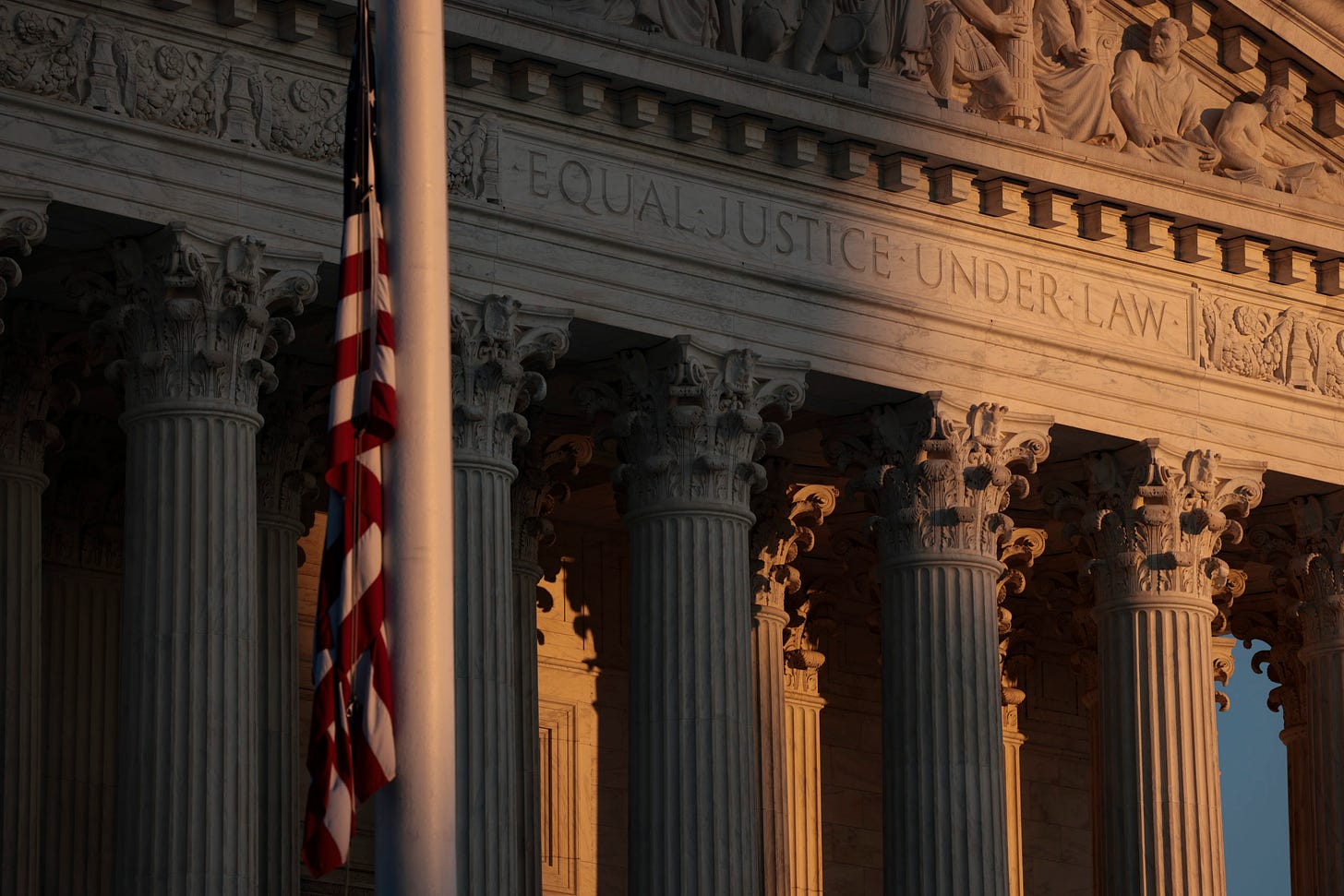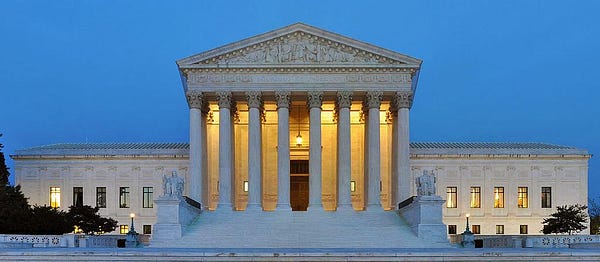

“If you dislike the religious right,” Ross Douthat said a few years back, “wait till you meet the post-religious right.” His point seemed to be that, by attacking evangelicals, the liberals of the mid-aughts helped clear the way for a more radical and conspiratorial form of conservatism. That’s debatable. But this much is certain: It can always get worse.
Someday, for example, the Supreme Court might conclude that Article II of the Constitution empowers the president to remove all executive officers at will. Now, you might not want the Court to do that. You might think it would be bad. But the history, text, and structure of the Constitution would support such a decision. The Court could base its ruling on a careful study of the Constitution’s Take Care Clause, the “Decision of 1789,” and precedents such as Myers v. United States (1926).
Alternatively, however, the Court could draw its cues from Donald Trump, who liked to boast that he had “an Article II” that gave him “the right to do whatever I want as president.” That, let’s agree, would be far worse. Especially if the ruling were part of a wider effort to create a “MAGA”-minded jurisprudence.
Granted, no federal judge is about to rule that Article II lets the president do “whatever” he wants. But is the judiciary at risk of taking a Trumpist turn?
“Donald J. Trump, the presumptive Republican presidential nominee, released a list of potential Supreme Court nominees on Wednesday as part of an effort to quell concerns that he would not select conservative jurists.” So begins a May 2016 article in the New York Times.
Concerns indeed. From the beginning, there were those who, looking upon the ignorance and inconsistency (political and otherwise) of a man best known for grunting “You’re fired” on television, worried that, should this man become president, the judicial nomination process would be marred by incompetence and distraction. The day Trump announced his candidacy, in June 2015, Don Willett, a respected conservative state supreme court justice, tweeted:


And that was before Trump mused, later that year, about placing his sister, a federal judge then in her late seventies, on the Court.
Even after Justice Antonin Scalia died the following February, Trump was saying that he wanted nominees willing (somehow) to “look very seriously” at Hillary Clinton’s “email disaster.” In the Senate, meanwhile, Mitch McConnell had procured for Trump the power, should he win the election, of picking Scalia’s replacement. The price was high. McConnell’s refusal to grant President Obama’s nominee, Merrick Garland, a hearing was an act of magnificent political vandalism. If, one day, the tale—the tragedy—of the cynical and corrosive brinkmanship that helped break the nation’s faith in the Supreme Court must be told, McConnell’s treatment of Garland will open the third act. McConnell, in short, had staked everything. But for what? Even if Trump should win, conservatives “fretted,” as the Guardian put it, “over the type of jurists the mercurial New Yorker might select.”
Then came the list. It did the trick. Crucially, although it was Trump’s list, it was not Trump’s list. Every person on it was a well-qualified judge shaped by a conservative legal movement that long predated a witless ape’s ride down an escalator. “I would not have been surprised to see this exact list from almost any of the other Republican candidates,” said one legal commentator at the time. Every member of the list would fit right in at a convention of the Federalist Society, the unofficial think tank, debate club, locker room, and job fair of legal conservatism. This was hardly surprising. FedSoc operators had a hand in the list’s creation.
Whatever chaos a Trump presidency might unleash on the conservative political world, the list seemed to promise that the conservative legal world would get to proceed with business as usual.
And that is, more or less, how things shook out. Trump won the election. He then tapped Neil Gorsuch—who’d been added to a second, expanded list in September 2016—to replace Scalia. Further expansions of the list followed. Trump’s other two Supreme Court nominees, Brett Kavanaugh and Amy Coney Barrett, each graced the list at some point. And it wasn’t just the list. Aided by prominent FedSoc members all along the way, the Trump administration loaded the lower federal courts, too, with bright and dedicated legal conservatives. Even Don Willett found his way onto the federal bench.
Trump’s judges drive liberals crazy. But that does not make them Trumpist judges; not in any noteworthy sense. There is nothing Trumpist about wanting to apply the law as written, or to respect the “original meaning” of the Constitution, or to resist the urge to act as a philosopher king, imposing an extralegal morality on the country. Yet these are the shared goals of what might be called “FedSoc judges” (a moniker, to be sure, that they would reject). FedSoc judges believe that the Founders still have much to teach us. They believe that the Constitution’s structural constraints are integral to limiting the power of government. They tend to believe that the Constitution requires greater federalism—less power in Washington, D.C., more power in the states. And yes, many of them believe in revoking some of the so-called rights that their leftwing judicial predecessors invented out of whole cloth.
Progressives may be allergic to much of this program, but, again, that does not make it Trumpist. In fact, precisely because they were so non-Trumpist, Trump’s judges gave conservatives something to rally around. Many Trump-skeptic and “Never Trump” Republicans conceded that when it came to judicial nominations, Trump generally said the correct things, kept his focus (!), and delivered. On the right, there was one issue, at least, where unity prevailed. Vote Republican. It’s the judges, stupid.
Then came Bostock.
Title VII of the Civil Rights Act of 1964 bans job discrimination based on race, color, religion, sex, or national origin. The question arises: Does the word “sex,” as used in that list, encompass sexual orientation and gender identity? In June 2020, in a 6-3 decision, the Supreme Court ruled that it does. If that weren’t enough to traumatize conservatives (though it was), the majority opinion was written by Justice Gorsuch, Trump’s first man on the Court, and it was an exercise in textualism. “An employer who fires an individual for being homosexual or transgender fires that person for traits or actions it would not have questioned in members of a different sex,” Gorsuch wrote. “Sex,” he concluded, thus “plays a necessary and undisguisable role in the decision, exactly what Title VII forbids.”
Conservative tears flowed. Speaking on the floor of the Senate, Josh Hawley called Bostock v. Clayton County a “seismic” decision. “If we’ve been fighting for originalism and textualism and this is the result,” he complained, “then I have to say it turns out we haven’t been fighting for very much.” Bostock “marks a turning point for every conservative,” Hawley claimed, “and it marks a turning point for the legal conservative movement.”
But a turning point to what? Some in the conservative legal movement have a ready response. A judge should bend the law toward the “common good,” they contend, with “common good” defined as outcomes conservatives like.
The hardliner will always be with us. There will always be that guy pushing jurists (only the ones on his ideological side, naturally) to abuse their power by resorting to results-oriented judging. In this instance, fortunately, the “common good” legal theory has yet to find a toehold in the federal judiciary. This might be because it is so obviously just the rightwing version of the leftwing judicial activism in opposition to which the Federalist Society was born. For Justice William Brennan, one of the great liberal activists of the mid-twentieth century, the magic label that released him from following rules was not “common good,” but “human dignity.” “Replace ‘common good’ with ‘human dignity,’” jeers Judge William Pryor, a conservative firmly of the FedSoc old school, and “living common goodism”—his derisive term for the “common good” movement—“sounds a lot like Brennan’s living constitutionalism.”
So, again, Bostock is supposed to be a turning point to what? The top-down intellectual effort to convince judges that the words “common good” are a license to distort the law is (so far) a bust. But what about bottom-up cultural forces inducing more “Trumpist” judicial behavior? True, the conservative legal movement is an elite movement. And many conservative judges were not appointed by Trump. And even Trump’s judges were groomed and selected more by the movement than by Trump himself. But judges do not live in caves. Can we expect conservative judges eventually to show signs of the paranoia, contempt, and Jacobinism that now dominates the American right? Will we get true Trump judges after all?
What would that look like? Trumpism is not complicated; it has a few core tenets. Always be fighting (more accurately, always be seen to be fighting). The system is rigged unless you win. Elites are dishonest, corrupt, and out to get you. Reward friends and punish enemies. A jurist who adopted these tenets would be not a FedSoc judge, but a Fight Club judge. Fight Club judging would, in many ways, be the opposite of FedSoc judging: less judicial restraint, more sharp-elbowed judicial tactics. Less respect for the rule of law, more attempts to own the libs. Less philosophy from the Founders, more talking points from Fox News.
Is a Trumpist judicial style emerging?
It’s hard to say. An uptick in sharply worded judicial opinions isn’t necessarily a tip-off. If federal judges employ a harder rhetorical edge these days, that’s likely because Justice Scalia and his acerbic pen made a lasting impression on the federal judiciary. Nor does a rise in judicial use of the demotic—court opinions that mention “shade-throwing,” or that toss in a “tl;dr,” or that quote Talladega Nights: The Ballad of Ricky Bobby—tell us much. Judges’ words are now dissected on—and thus, perhaps, increasingly written with an eye toward—social media. (And of course, what counts as proper English usage is forever evolving.)
“I am Jack’s smirking revenge,” sneers Fight Club’s nihilistic narrator. Well, witness the signs of Jack’s creeping taste for judicial Trumpism. There was the opinion, written by a Trump appointee on the U.S. Court of Appeals for the Fifth Circuit, that ostentatiously refused to use an inmate’s preferred pronouns. There was the crankish rant, shoehorned by a D.C. Circuit judge into an utterly unrelated case, against the “shocking” bias and “un-American” behavior of Twitter, Facebook, the New York Times, and NPR. (Fox News got a pat on the head for being one of the “few notable exceptions,” in the media, “to Democratic Party ideological control.”) Then there was the Trump appointee on the Ninth Circuit who, after striking down a gun regulation, served up an entire “mock” opinion, for the benefit of his liberal colleagues, setting forth how to reverse his ruling. He added footnotes with self-described “thought-bubbles” (“Whew. Hard work done. It’s all downhill from here!”), and signed off with “You’re welcome.”
Still, a few examples of Jack’s raging bile duct does not a revolution make. There is, as yet anyway, no cadre of Fight Club judges who can reliably be distinguished from their FedSoc counterparts.
If a sorting is to occur, look for it to start in cases involving Big Tech.
Consider the ongoing litigation over two state social media laws, Florida’s SB 7072 and Texas’s HB 20. Each law takes aim at supposed “Big Tech censorship.” Accordingly, each contains a thicket of rules intended to block or discourage the largest social media platforms from moderating content. SB 7072 says, for instance, that a platform may not remove any post by a “journalistic enterprise,” a term defined so as to cover most any popular website. Florida’s law also requires platforms to moderate content in a “consistent manner”—whatever that means. HB 20, for its part, bars a platform from moderating content on the basis of “viewpoint.” It thus would seem to place terrorist propaganda on a par with news stories about terrorism, mass-shooter manifestos on a par with appeals for racial harmony or gun control, pro-anorexia content on a par with its opposite, and so on. Allow the latter, and, under HB 20, you must allow the former.
Each law was challenged in court, and each was blocked. “The State has asserted it is on the side of the First Amendment,” wrote the trial judge in the Florida case, “but the assertion is wholly at odds with accepted constitutional principles.” “Social media platforms have a First Amendment right to moderate content disseminated on their platforms,” explained the trial judge in the Texas case; yet “HB 20 prohibits virtually all content moderation.” The First Amendment violations were clear.
FedSoc judges led the way in ensuring that these rulings were not just plausible outcomes, but obvious ones. It is FedSoc judges who have long defended the speech rights of corporations. It is FedSoc judges who recently confirmed that the Free Speech Clause constrains not private actors, but the government. And it was perhaps the greatest FedSoc judge of them all, Justice Scalia, who insisted that First Amendment rights “do not vary when a new and different medium for communication appears.”
Both trial court rulings were appealed. Florida is in the conservative-leaning Eleventh Circuit, Texas in the conservative-leaning Fifth Circuit. Each appeal drew a panel of three Republican-appointed judges. But the similarities end there.
The Eleventh Circuit upheld most of the trial court’s order. Judge Kevin Newsom, a Trump appointee, last month found for a unanimous panel that “social-media companies—even the biggest ones—are private actors whose rights the First Amendment protects.” SB 7072’s restrictions, Newsom went on, “unconstitutionally burden” the platforms’ “protected exercises of editorial judgment.” Indeed, Florida itself should know as much. By objecting that “‘Big Tech’ companies harbor a ‘leftist’ bias against ‘conservative’ perspectives,” Newsom said, SB 7072’s sponsors had in effect admitted that “platforms express themselves”—in a way the legislators dislike—“through their content-moderation decisions.” SB 7072 is at root an attempt to boost rightwing speech on social media. But as Newsom observed, “there’s no legitimate . . . governmental interest in leveling the expressive playing field.”
In the Fifth Circuit things went rather differently. It started at the oral argument, which Judge Edith Jones, a Reagan appointee, treated more like a talk radio segment. Early on, she declared the major platforms “de facto monopolies.” (Judge Newsom understood that that point is not “uncontroversial.” The use of the word “monopolies,” plural, is suggestive in that regard.) The platforms, Jones later volunteered, have “censored” some “very hotly disputed things,” such as claims about “the election of 2020.” She seemed to distinguish between “content moderation” (which she wrongly called “commercial speech”) and “censorship,” a tag apparently reserved for content moderation she doesn’t like.
The platforms, a lawyer noted at one point, must make billions of content moderation decisions a month. “We learned at the Fifth Circuit Judicial Conference,” Jones saw fit to reply, that “they’re not too good about removing Russian bots.” (And thus . . . what? Texas can pass a law that effectively bars platforms from removing Russian bots?) In addition to the “viewpoint” command, HB 20 contains various disclosure requirements. “I just have a very difficult time assessing the argument,” Jones stated, that “the richest companies in the world” cannot meet those requirements. (The argument, which is not all that hard to “assess,” is that legislators may not impose disclosure rules as a means of influencing an entity’s editorial decisions.)
Throughout, Jones seemed more interested in airing populist grievances against Big Tech than in weighing facts or legal arguments. Meanwhile, another judge on the panel, Trump appointee Andy Oldham, was, though more professional in his bearing, no less open in conveying his underlying views. The platforms, he clearly thought, have had it too easy, from a regulatory standpoint, for too long. It felt like the fix was in.
And so it proved. Texas had moved to stay the trial court’s order (that is, to let HB 20 take effect) pending resolution of the appeal. Two days after the argument, in a 2-1 decision containing no written opinion, the Fifth Circuit panel granted the motion.
The trade groups representing the platforms were sent scrambling to the Supreme Court, where they applied for an emergency order vacating the Fifth Circuit’s one-sentence ruling. Rarely does the Court act before an appellate court is even done with the case. Then again, rarely does an appellate court go full Fight Club and trash the First Amendment without even bothering to explain itself. So it was hardly surprising that five justices agreed to grant relief here. Among them were Trump appointees Kavanaugh and Barrett. A sixth—Elena Kagan—voted to deny the application, almost certainly because she opposed granting such extraordinary relief, rather than because she approved of the Fifth Circuit’s conduct. (She lodged no opinion.)
Three of the conservative justices—Samuel Alito, joined by Neil Gorsuch and Clarence Thomas—dissented. “Whether applicants are likely to succeed under existing law,” Alito submitted, “is quite unclear.” It could be “unclear,” however, only to judges willing to junk the First Amendment jurisprudence built by the FedSoc movement. Writing in Slate the next day, Mark Joseph Stern offered a reasonable assessment of what Alito’s dissent had revealed. “It is now evident,” he proposed, “that the most reactionary justices have adopted the Republican Party’s baseless paranoia about ‘Big Tech’ censoring conservatives—and adjusted their jurisprudence accordingly.”
The Fifth Circuit still has not spelled out its reasoning.
In 1985, while serving as attorney general, Ed Meese gave a speech highlighting the cause of the young Federalist Society. With originalism, Meese asserted, the Supreme Court could “produce defensible principles of government that would not be tainted by ideological predilection.” It “could avoid both the charge of incoherence and the charge of being either too conservative or too liberal.”
Progressives have never taken these sentiments that seriously. So much the worse for them, conservatives have tended to respond. The values of the founding are worth fighting for. What’s more, no legitimate source of authority lets judges depart from the original meaning of the constitutional text. And anyway, what would liberals have conservatives do? Remember, it can always get worse. These days, it usually does.
If you dislike FedSoc judges, wait till you meet Fight Club judges.











